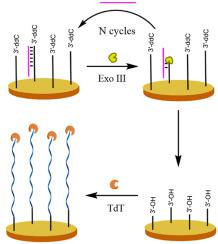当前位置:
X-MOL 学术
›
Anal. Chim. Acta
›
论文详情
Our official English website, www.x-mol.net, welcomes your
feedback! (Note: you will need to create a separate account there.)
Highly sensitive detection of lipopolysaccharide based on collaborative amplification of dual enzymes
Analytica Chimica Acta ( IF 5.7 ) Pub Date : 2020-08-01 , DOI: 10.1016/j.aca.2020.06.013 Yue Huang 1 , Lei Wang 2 , Lingjun Sha 3 , Yaosong Wang 4 , Xuguo Duan 4 , Genxi Li 5
Analytica Chimica Acta ( IF 5.7 ) Pub Date : 2020-08-01 , DOI: 10.1016/j.aca.2020.06.013 Yue Huang 1 , Lei Wang 2 , Lingjun Sha 3 , Yaosong Wang 4 , Xuguo Duan 4 , Genxi Li 5
Affiliation

|
In this work, a novel electrochemical biosensor is developed for facile and highly sensitive detection of lipopolysaccharide (LPS) based on collaboration of dual enzymes for multiple-stages signal amplification. Through ingenious design, the specific recognition of target LPS is transformed to the exonuclease III (Exo III)-assisted interface DNA cycling collaborated with the terminal deoxynucleotidyl transferase (TdT)-catalyzed DNA extension, finally inducing significant electrochemical signal concerned with the concentration of LPS. This paper mainly discusses the detection principle, optimization of key factors, and the analytical performance of the biosensor. With the efficient signal amplification, the biosensor shows high sensitivity with a good linearity and a low limit of detection of 1 pg mL-1 for LPS. Moreover, the developed biosensor can clearly discriminate LPS from interferents and show high specificity for LPS detection. This biosensor has also been successfully employed to measure LPS in real food samples, suggesting potential opportunity for application in food safety detection.
中文翻译:

基于双酶协同扩增的脂多糖高灵敏度检测
在这项工作中,基于双酶协作进行多级信号放大,开发了一种新型电化学生物传感器,用于脂多糖 (LPS) 的简便和高灵敏度检测。通过巧妙的设计,将目标LPS的特异性识别转化为核酸外切酶III(Exo III)辅助界面DNA循环与末端脱氧核苷酸转移酶(TdT)催化的DNA延伸,最终诱导出与LPS浓度有关的显着电化学信号. 本文主要讨论了生物传感器的检测原理、关键因素的优化和分析性能。通过有效的信号放大,生物传感器显示出高灵敏度、良好的线性和 LPS 检测下限为 1 pg mL-1。而且,开发的生物传感器可以清楚地区分 LPS 和干扰物,并显示出对 LPS 检测的高度特异性。该生物传感器也已成功用于测量真实食品样品中的 LPS,这表明其在食品安全检测中的应用具有潜在的机会。
更新日期:2020-08-01
中文翻译:

基于双酶协同扩增的脂多糖高灵敏度检测
在这项工作中,基于双酶协作进行多级信号放大,开发了一种新型电化学生物传感器,用于脂多糖 (LPS) 的简便和高灵敏度检测。通过巧妙的设计,将目标LPS的特异性识别转化为核酸外切酶III(Exo III)辅助界面DNA循环与末端脱氧核苷酸转移酶(TdT)催化的DNA延伸,最终诱导出与LPS浓度有关的显着电化学信号. 本文主要讨论了生物传感器的检测原理、关键因素的优化和分析性能。通过有效的信号放大,生物传感器显示出高灵敏度、良好的线性和 LPS 检测下限为 1 pg mL-1。而且,开发的生物传感器可以清楚地区分 LPS 和干扰物,并显示出对 LPS 检测的高度特异性。该生物传感器也已成功用于测量真实食品样品中的 LPS,这表明其在食品安全检测中的应用具有潜在的机会。











































 京公网安备 11010802027423号
京公网安备 11010802027423号